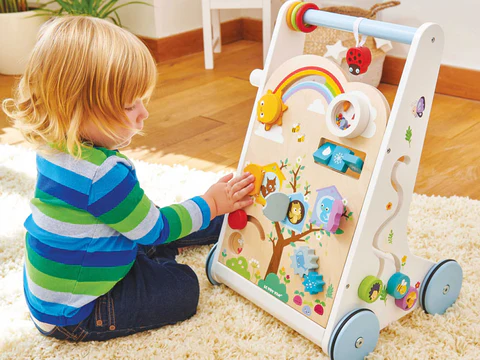As babies begin to explore the world around them, every new sound, texture, and colour becomes an opportunity for discovery. Sensory play is a vital part of their early development, helping to stimulate their senses and encouraging cognitive, emotional, and physical growth.
In this article brought to you by Samuel Sensory, we’ll explore the key benefits of sensory play and highlight essential sensory toys that can help nurture your baby’s development from the earliest stages.
What Is Sensory Play?
Sensory play refers to activities that engage and stimulate a baby’s senses, including touch, sight, sound, smell, and taste. These activities encourage babies to explore their environment through hands-on experiences, using objects, textures and sounds to enhance their understanding of the world around them.
Importance of Sensory Play:
Sensory play plays a critical role in a baby’s growth and development. By stimulating their senses, these activities help develop crucial brain functions, including cognitive skills, and problem-solving abilities. Sensory play also sparks curiosity and encourages babies to explore and learn through trial and error. As babies engage with different sensory inputs, their brains form important neural connections that aid in memory, learning, and emotional regulation.
Additionally, sensory play supports language development as caregivers interact and describe the sensory experiences, fostering communication and bonding. Ultimately, sensory play lays a strong foundation for a baby’s overall physical, social, and intellectual growth.
Cognitive Benefits of Sensory Play
Building Neural Pathways:
Sensory play is essential for developing and strengthening neural pathways in a baby’s brain. Every time a baby engages with different textures, sounds, or visual elements, their brain responds by forming new connections that support cognitive development.
For example, when a baby feels the difference between a smooth ball and a textured one, their brain processes this information, reinforcing sensory and motor pathways. These neural connections are vital for helping babies interpret their surroundings, learn patterns, and understand how the world works, laying the groundwork for more complex thought processes as they grow.
Encouraging Problem Solving:
Sensory play also promotes early problem-solving skills. When babies interact with sensory toys, they begin to understand cause and effect.
For instance, shaking a rattle produces sound, or pressing a soft toy creates a new shape. These discoveries encourage babies to experiment and explore different actions to achieve desired results, fostering a natural curiosity and a proactive approach to learning. Over time, this exploration of their environment helps them build logical thinking and problem-solving abilities from an early age.
Language Development:
Sensory experiences offer wonderful opportunities for language development. As babies engage with sensory toys, caregivers can describe the textures, sounds, and objects they are exploring, which helps build vocabulary.
For example, saying phrases like “This ball feels soft” or “Do you hear the bell?” introduces babies to new words and concepts. This not only enhances language acquisition but also strengthens the bond between the baby and caregiver through interactive communication. Sensory play provides a rich environment for babies to connect language with physical experiences, accelerating their understanding of the world.
Essential Sensory Toys for Babies’ Development
Tactile Toys: Tactile toys engage a baby’s sense of touch by allowing them to explore different textures. Soft fabrics, textured balls, and sensory boards with materials like velvet, corduroy, or rubber encourage babies to feel, grasp, and interact with objects. These toys help develop fine motor skills and tactile awareness. Sensory balls with bumps or grooves, along with crinkle books, are also great for stimulating the sense of touch in a playful way.
Visual Stimulation Toys: Visual development is key in the early stages of a baby’s life. Brightly coloured toys, high-contrast images, and light-up toys capture a baby’s attention and help them focus on visual details. Toys like black-and-white mobiles, picture cards, and those with moving parts encourage babies to track objects with their eyes and distinguish between different colours and shapes, strengthening their visual perception.
Auditory Toys: Toys that make sounds are ideal for helping babies develop auditory skills. Rattles, musical toys, and items that produce crinkling or jingling noises introduce babies to different sounds, while also helping them understand cause and effect. For a calming experience, soft toys with soothing sounds like lullabies or white noise can provide comfort while still engaging their sense of hearing.
Teething Toys: Teething toys serve a dual purpose, offering sensory stimulation while also providing relief for teething babies. Toys made from soft, safe materials like silicone or rubber are perfect for babies to chew on. Some teething toys also have textured surfaces that stimulate the gums, making them both soothing and engaging for little hands to hold.
Scented and Taste-Safe Toys: For older babies, toys that engage the senses of smell and taste add another dimension to sensory play. Taste-safe toys like scented playdough or natural teething biscuits allow babies to safely explore new tastes and smells. Scented soft toys or blankets, infused with calming fragrances like lavender, can also help introduce babies to different scents in a safe and soothing way.
Thank you for taking the time to read about the benefits of sensory play and the essential toys that can support your baby’s development. We hope this guide has provided you with valuable insights and ideas for incorporating sensory experiences into your baby’s everyday routine.












